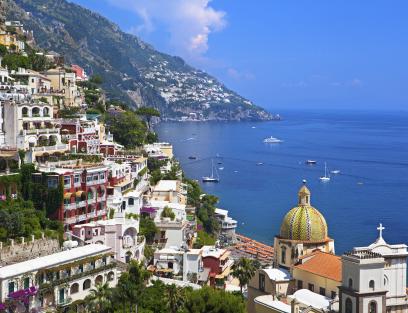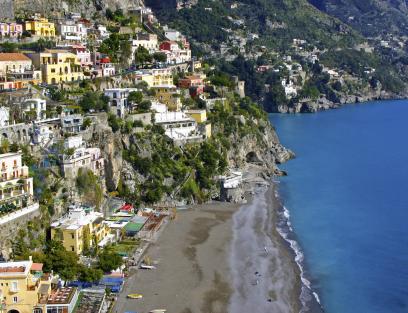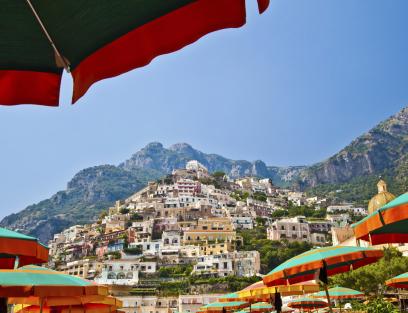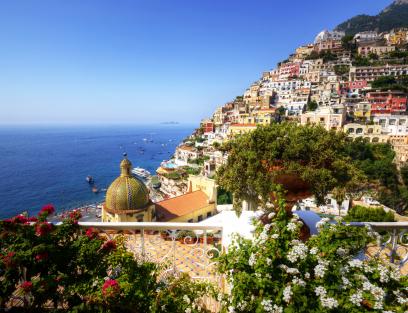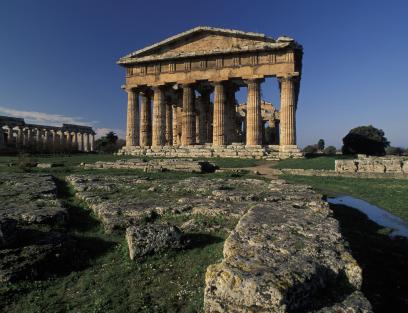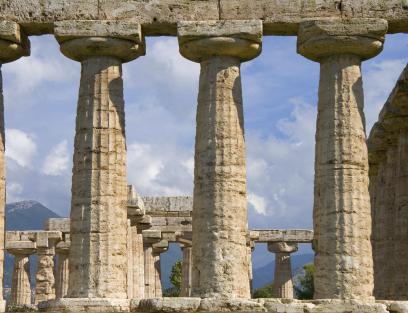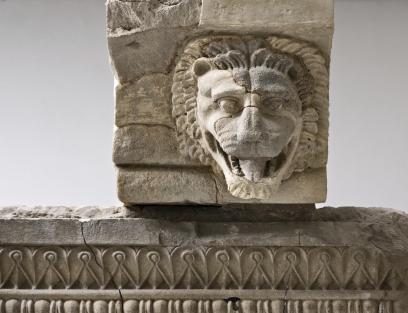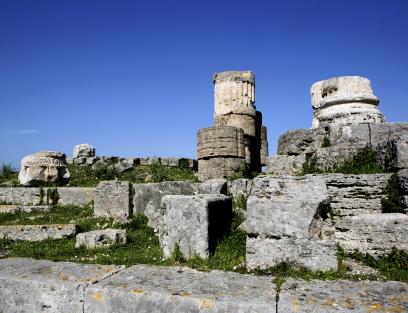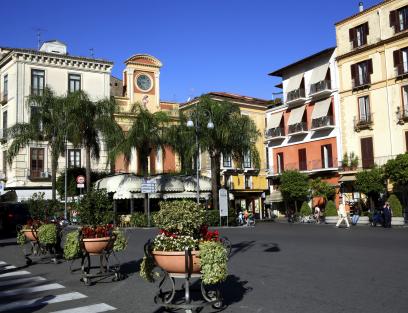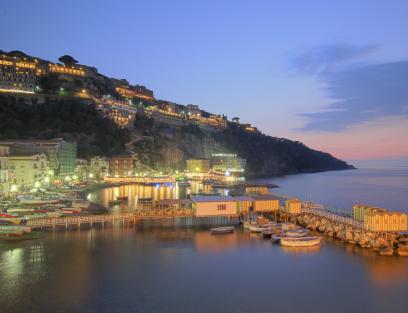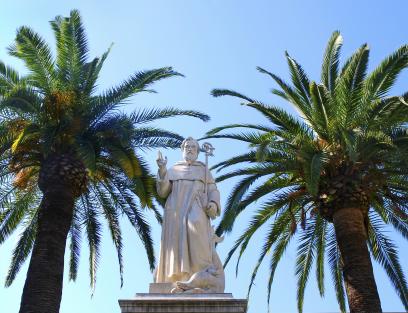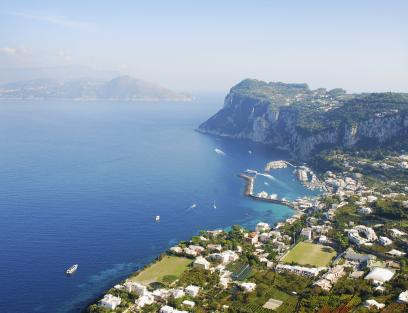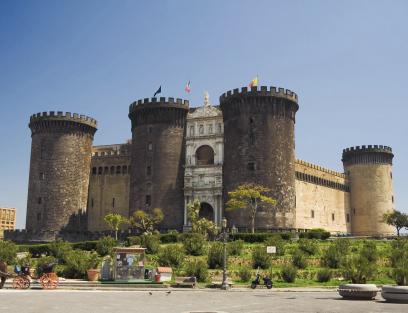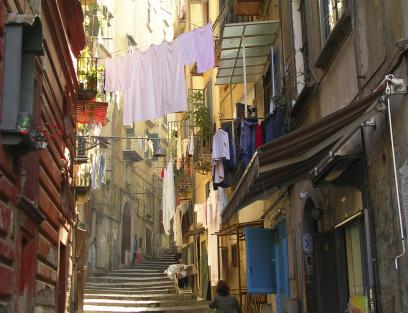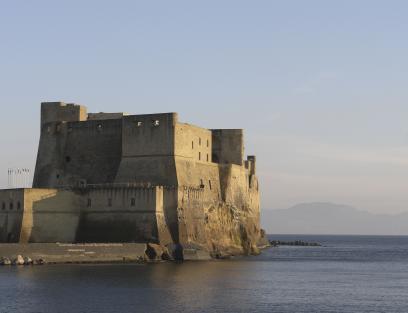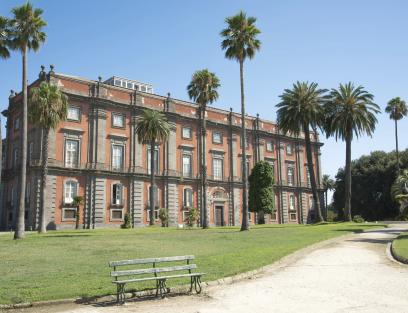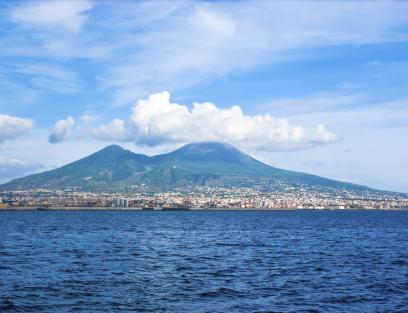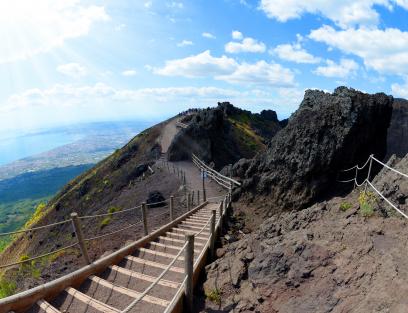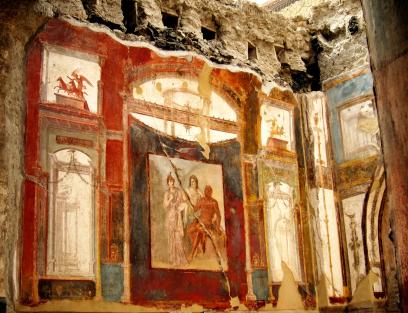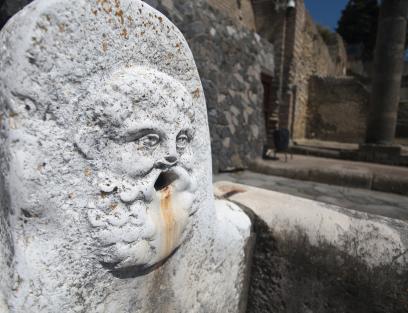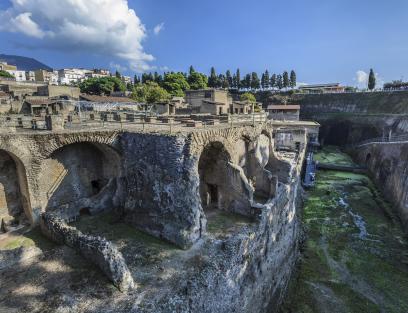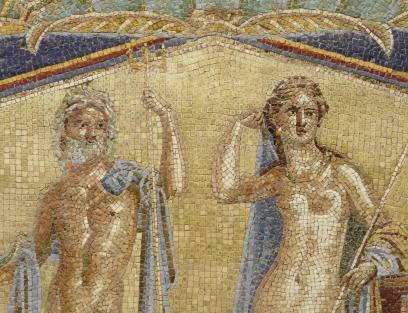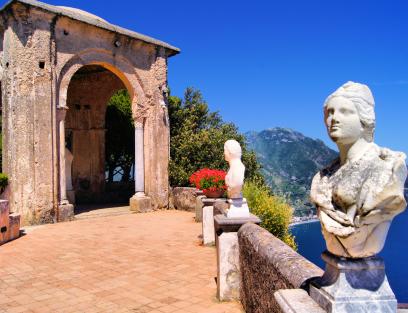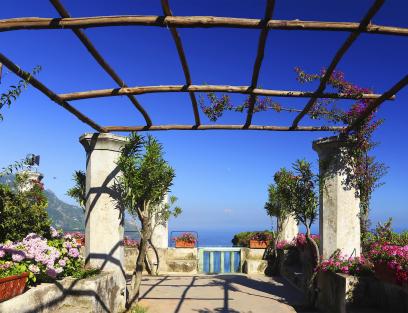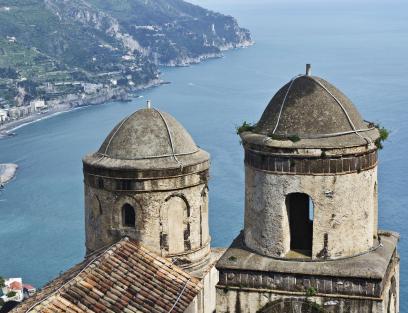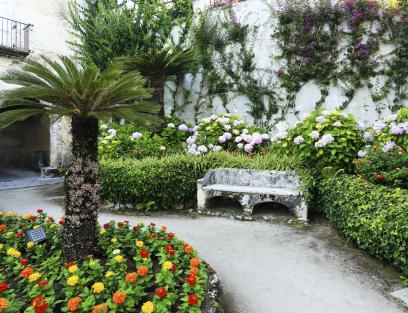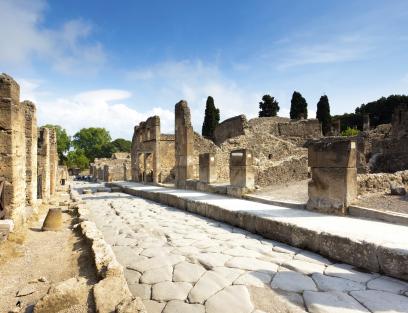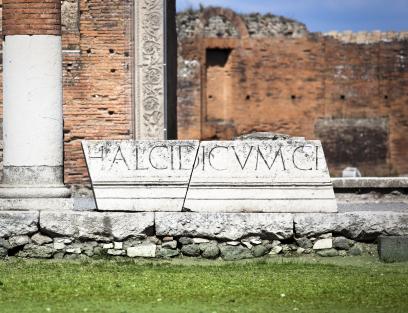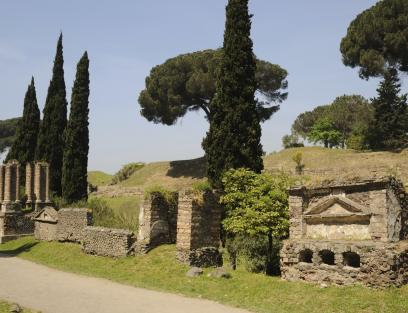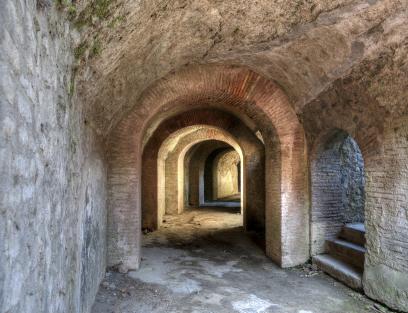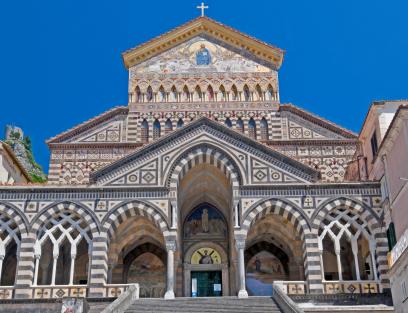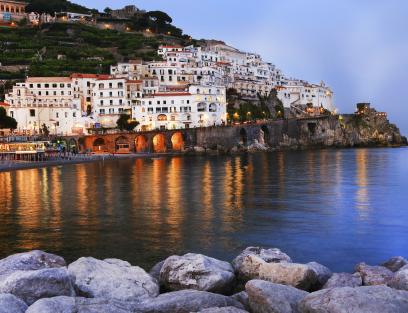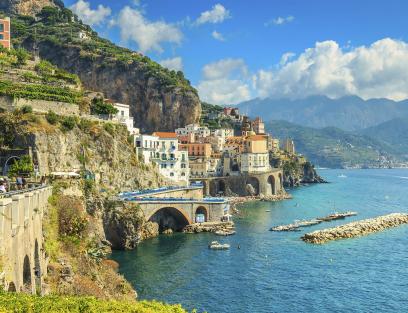Positano is known as the jewel of the Amalfi Coast. Just one glimpse of this town and you understand why. Positano is a vertical town with beautiful colorful buildings climbing from the beach below up to the top of its steep mountain side. Roads are replaced by little paths and cascading steps. Positano has been the setting for many films and the inspiration of Authors and song writers. In fact Mick Jagger and Keith Richards wrote the Rolling Stones song “Midnight Rambler” while enjoying a holiday in Positano and relaxing in one of its many cafes. Shops and boutiques line the many streets with designer fashion that Positano has become known for. It’s name is Positano fashion beachwear. There are many shops that make handmade products such as clothes, pottery, linen and sandals. The name of the town dates back to the sea god Neptune.
Paestum was a major ancient Greek city located in the province of Salerno. Recognized as a UNESCO world heritage site, Paestum offers a unique opportunity to see Temples built in the first part of the 6th century. It was eventually conquered by the Lucanians and then later the Romans. You can also see painted tombs belonging to the Lucanian rule. There is also a Roman forum, an amphitheater and several temples. The main 3 important temples are The Temple of Hera built around 550 BC and the oldest surviving temple. The temple of Hera No 2 which was built around 450-460 BC and the Temple of Athena built around 500 BC. Paestum gives you a chance to see ancient Greek architecture.
ENTRANCE FEES OPTIONAL
Temple of Paestum & Paestum Museum: Kombo tickets € 12
Under 18s and over 65s go free but will need to produce a valid European Passport
Sorrento is the most popular resort on the Sorrentine Coast. Known for its production of Limoncello, wine and citrus fruits. It is also famous for their inlaid wood products. The town overlooks the Bay Of Naples and is full of beautiful shops, restaurants and cafes. Sorrento’s sea cliffs have attracted people including Enrico Caruso and Luciano Pavarotti. Sorrento was the birthplace of the famous poet Torquato Tasso and the house where he was born has become a famous hotel (Hotel Tramontano ). The main square has his monument and also takes his name. Giambattista de Curtis and his brother wrote a famous song called “Torna a Surriento” which later was sung by Elvis Presley. They changed the lyrics to English and changed the name to “Surrender”. This song in Italian sings about the sheer beauty of Sorrento.
See Naples and die!
The famous proverb is “See Naples and die”. This is because Naples is rich in history, art, tradition and dominates the Bay Of Naples. Where else is a city surrounded with so much beauty like The Islands of Capri, Procida and Ischia and looking over the bay towards Sorrento and the Sorrentine peninsula. It really has to be one of the most beautiful views on earth. There are so many things to see and do in Naples. Why not stop and have a pizza for lunch after all the first Pizza was invented here for Queen Margarita. However it’s not just the cuisine that makes this place special but also some of the buildings. The National history Museum holds most of the objects that were excavated from nearby Pompeii and Herculaneum. The museum is the most important archaeological museum in Italy. The museum hosts an extensive collection of not just Roman Antiques but also Greek. It also has a major collection of Roman bronzes that were taken from the Villa Of The Papyri in Herculaneum. Naples also has an important cathedral called “ St Gennaro’s Cathedral” who is also the patron Saint of Naples. The church houses a vial of St Gennaro’s blood in its crypt which is brought out twice a year (the first Saturday in may and 19th September) when the dried blood liquefies. If the blood fails to liquefy then legend has it that a disaster will befall Naples. Also there is the Capodimonte Museum. This is an important art museum for art lovers. It holds the most important Neapolitan painting and decorative art. Some of the rooms are filled with Roman sculptures, 13th to 18th century art and 18th century furniture.
ENTRANCE FEES OPTIONAL
National Archaeological Museum € 10 opening times 9am-8pm every day except Tuesday
Capodimonte Museum € 10
Naples Cathedral free entrance
Under 18s and over 65s go free but will need to produce a valid European Passport
One of the most famous and studied Volcanos in the world. You have a unique opportunity to make the way up to the top and see not only the crater but the most amazing view of the Gulf of Naples. The height of the main cone is 1,281 mt and is still regarded as an active volcano. The most famous eruption was in 79AD which caused devastation and has had several eruptions since. The last one was 1944 which was very slight in comparison to 79AD! It is the only Volcano on European mainland to have erupted in the last hundred years and is regarded as the most dangerous volcano in the world due to the 3,000,000 in habitants that live nearby. It is the most densely populated volcanic region in the world. The area around Vesuvius was officially declared a National Park in 1955.
ENTRANCE FEES OPTIONAL
Mount Vesuvius € 10.00
An 1 and a half hours is recommended for this visit.
Herculaneum known in modern Italian as Ercolano is another famous archaeological site buried by the 79AD eruption of Vesuvius. Herculaneum however was not covered by the thick hot lava but was covered by a mudslide which didn’t destroy the wooden houses. Herculaneum is a must because it has been preserved by the mud rather than damaged by hot lava plus the roofs are still intact because the mudslide was deep enough to cover the houses. The hot ash has even preserved wooden objects such as beds, doors and even food! Herculaneum was a wealthier town than Pompeii and so the villas are far more lavish. It was thought that most of the inhabitants escaped that day but yet in 1981 they found hundreds of skeletons of men, women and children. It’s worth a visit to the site because of just how intact and well preserved it is. In 1977 it was declared a World Heritage Site.
ENTRANCE FEES OPTIONAL
Herculaneum € 13
A 2 hour visit is recommended
Authorized guide can be organized at an extra cost
Under 18s and over 65s go free but will need to produce a valid European Passport
Ravello is extremely popular with tourists because of its location and scenic beauty. Set 315 meters above sea level, Ravello has a small population of just 2500 inhabitants. Ravello in the past was famous for its Noble families who lived there and were known by the name “Patricians of Ravello”. No wonder the town attracted such elite people as the view from the town has to be one of the most beautiful on the Amalfi Coast. The main sights in Ravello are Villa Cimbrone and Villa Ruffolo. The Villa Cimbrone was brought by Ernest Beckett in 1904 and together with a tailor barber builder from Ravello who he met in England, he set to work on the restorations. The beautiful flowers, the Armida’s orchards and the backdrop of the deep blue sea makes the villa a must see and one of the best points to get probably the most beautiful view from this very high location. Villa Ruffolo was owned by the most powerful and wealthy family known by the same name “Ruffolo”. Some of the rooms form a small museum and the courtyard is an elevated cloister. The German Opera composer Richard Wagner visited the villa in 1880 and one of his pieces was inspired by the sheer beauty of the villa. In fact the lower garden hosts a Wagnerian Concert every year in commemoration.
ENTRANCE FEES OPTIONAL
Villa Ruffolo € 7
Villa Cimbrone € 7
Pompeii is the most famous archaeological site in the world that lies at the foot of the Volcano Vesuvius. It became a Roman city in about 80 BC and grew into a flourishing city port. It was a prosperous resort and had numerous wealthy visitors. It contained wealthy villas, amphitheatre, 2 theatres and several temples along with its very own sophisticated aqueduct system. The Romans were ahead of their time. In 62AD a severe earthquake struck the city and did significant damage. It took years to get the city back to how it was. In 79ad disaster struck again and Vesuvius erupted pouring thick, boiling lava all over the city. The inhabitants had little time to escape. The eruption buried the city and 20,000 inhabitants were blasted with temperatures of up to 250 degrees C. People hiding in stone buildings couldn’t escape from the heat. The lava preserved the city and it was left uncovered until 1748. From then on the site became so important with its discoveries that they were finding things all the time. A UNESCO world heritage site, Pompeii gives you the unique opportunity to see how the Romans lived. See their villas, theaters and shops and breath in life as it was then. You will need a minimum of 2 hours to see only highlights of the archeological sites.
ENTRANCE FEES OPTIONAL
Pompeii € 16
Authorized guide can be organized at an extra cost
A minimum 2 hours tour is recommended and in 2 hours you will see only a part of this enormous site.
Under 18s and over 65s go free but will need to produce a valid European Passport
Amalfi is a maritime town and in the past was one of the most important ones. In the 4th century it became one of the four maritime republics along with Venice, Genoa and Pisa. In medieval times Amalfi was famous for its flourishing schools for mathematics and law and Flavio Gioia who first invented the compass is said to have been a native. Between 839 to 1200 it was an important trading power in the Mediterranean. Amalfi is not only steeped in Maritime history but also is a beautiful, stunning place to visit. Lying at the foot of Monte Cerreto, it is surrounded by fantastic scenery, dramatic cliffs and blue sea. So beautiful that in the 1920’s and 30’s it was a popular holiday destination for British upper class aristocracy. Amalfi is included in the UNESCO World Heritage sites. Don’t miss the beautiful Cathedral which lies at the top of the stairs in Piazza Duomo. The Cathedral contains the tomb of St Andrew, its name sake, in its crypt. The saint of Amalfi is of course St Andrew and the feast days are 26-27 June and 30th November. On the first day in June there is a historic regatta. A historic rowing competition among the four main Italian Maritime republics, Amalfi, Genoa, Pisa and Venice. It comes to Amalfi every 4 years as every town has the chance to host the event.
ENTRANCE FEES OPTIONAL
St Andrew’s Cathedral € 3
